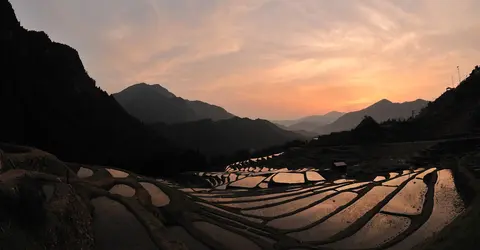1,000 rice fields of Maruyama Senmaida 丸山千枚田
- Published on : 30/04/2018
- by : C.L
- Youtube

The rice fields in the middle of the mountains
Helohelon
Puzzle terraces
In the south of Mie prefecture hides a small jewel of Japanese agriculture: the rice terraces of Maruyama Senmaida.
Winding roads winding through the mountains, thick cedar forests and villages that seem to be frozen in time, the road that takes you to the rice terraces of Maruyama Senmaida is worth the detour in itself , giving this impression of traveling in a Japan still preserved from the crowd and revealing its wild side .
After passing the town of Kiwa, the rice fields are finally available to you. In front of your eyes, more than a thousand rice fields with contours drawn in the rock . A thousand small basins with irregular shapes, assembled like a puzzle extending over a drop of 100 meters .
A feast for the eyes, the rice fields offering their most beautiful finery in all seasons . If in winter they are immaculate because covered with snow, they take on the appearance of mirrors of water in mid-spring during planting, while in summer they are adorned with a bright green, undulating to the rhythm of the wind.
- Read also: Rice in Japan
Meticulous work
If these rice fields are a delight for the traveler, they require on the other hand a lot of work on the part of the farmers. Indeed, it is impossible for machines to venture into this cereal maze . They therefore have to plant, maintain and harvest by hand . But above all preserve this heritage which almost disappeared.
Sculpted over more than 400 years, around 2,200 rice fields made up the site of Maruyama Senmaida in the 16th century. With the rise of machine tools, farmers have gradually deserted these terraced rice fields which required enormous human investment for a lower yield than the rice fields on the plateau where the machines imposed their mechanical speeds.
- Read also: 10 places to discover in Mie
A legacy to preserve
Thus, in 1950, there were only 500 rice fields still in operation . The local authorities immediately reacted in order to preserve this ancestral heritage, which ensured, in addition to a subsistence role, a key element in the control of erosion , by allocating subsidies to farmers ensuring the preservation of these rice terraces of Maruyama Senmaida.
Always with the aim of raising awareness among the local population of the importance of these rice fields, a festival is organized there in mid-May . Festival-goers dress in traditional clothes and engage in various dances in the middle of the terraces to thank the gods, while praying for a bumper harvest. The festival ends with the planting of rice, in which locals and visitors are invited to participate. A very good way to discover Japanese rurality a little better.
- Read also: The rice transplanting festival in Hiroshima


















